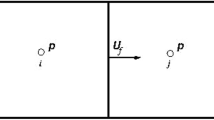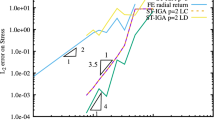Abstract
In part I of the paper (see Zlamal [13]) finite element solutions of the nonstationary semiconductor equations were constructed. Two fully discrete schemes were proposed. One was nonlinear, the other partly linear. In this part of the paper we justify the nonlinear scheme. We consider the case of basic boundary conditions and of constant mobilities and prove that the scheme is unconditionally stable. Further, we show that the approximate solution, extended to the whole time interval as a piecewise linear function, converges in a strong norm to the weak solution of the semiconductor equations. These results represent an extended and corrected version of results announced without proof in Zlamal [14].
Similar content being viewed by others
References
J. Bergh, J. Löfström: Interpolation Spaces. Springer Verlag, Berlin-Heidelberg-New York, 1976.
J. Céa: Optimization. Dunod, Paris, 1971.
P.G. Ciarlet: The Finite Element Method for EllipticProblems. North-Holland, Amsterdam-New York-Oxford, 1978.
J. F. Ciavaldini: Analyse numérique d'un probl'eme de Stefan 'a deux phases par une méthode d'eléments finis. SIAM J. Numer. Anal. 12 (1975), 464–487.
D. Gilbarg, N. S. Trudinger: Elliptic Partial Differential Equations of Second Order. Springer-Verlag, Berlin-Heidelberg-New York, 1977.
V. Giraud, P. A. Raviart: Finite Element Approximation of the Navier-Stokes Equations. Springer-Verlag, Berlin-Heidelberg-New York, 1979.
G. Grisvard: Behaviour of the solutions of an ellipticb oundary value problem in a polygonal or polyhedral domain. In: Numerical Solution of Partial Differential Equations-III (B. Hubbard, ed.). Academic Press, New York-San Francisco-London, 1978, pp. 207–274.
A. Kufner, O. John and S. Fučík: Function Spaces. Academia, Prague, 1977.
J. L. Lions: Quelques Méthodes de Résolution des Probl'emes aux Limites Non Linéaires. Dunod Gauthier-Villars, Paris, 1969.
J. Nečas: Les Méthodes Directes en Théorie des Equations Elliptiques. Academia, Prague, 1967.
R. Rannacher, R. Scott: Some optimal error estimates for piecewise linear finite element approximations. Math. Comp. 38 (1982), 437–445.
P. A. Raviart: The use of numerical integration in finite element methods for solving parabolic equations. In: Topics in Numerical Analysis (J. J. H. Miller, ed.). Academic Press, London-New York, 1973, pp. 233–264.
M. Zlámal: Finite element solution of the fundamental equations of semiconductor devices I. Math. Comp. 46 (1986), 27–43.
M. Zlámal: Finite element solution of the fundamental equations of semiconductor devices. In: Numerical Approximation of Partial Differential Equations (E. L. Ortiz, ed.). North-Holland, Amsterdam-New York-Oxford-Tokyo, 1987, pp. 121–128.
M. Zlámal: Curved elements in the finite element method I. SIAM J. Numer. Anal. 10 (1973), 229–240.
Author information
Authors and Affiliations
Rights and permissions
About this article
Cite this article
Zlamal, M., Zenisek, A. Finite Element Solution of the Fundamental Equations of Semiconductor Devices II. Applications of Mathematics 46, 251–294 (2001). https://doi.org/10.1023/A:1013748108936
Issue Date:
DOI: https://doi.org/10.1023/A:1013748108936




